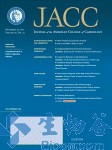Circulation Ep:心衰患者CRT-D植入后的LVEF与室性心律失常ICD治疗的关系
2013-05-20 Circulation Ep dxy
CRT(cardiac resynchronization therapy)可减轻心衰患者的心衰症状并减少住院次数,改善心衰患者预后。它可以提高一部分患者的左室射血分数(LVEF),在一个小规模的亚组研究中,尽管约25-30%的患者临床改善不明显,但CRT确实可使患者的心室功能接近正常,这部分患者称为超级反应患者(super-responders),其定义为CRT植入后LVEF>=45%。有
CRT(cardiac resynchronization therapy)可减轻心衰患者的心衰症状并减少住院次数,改善心衰患者预后。它可以提高一部分患者的左室射血分数(LVEF),在一个小规模的亚组研究中,尽管约25-30%的患者临床改善不明显,但CRT确实可使患者的心室功能接近正常,这部分患者称为超级反应患者(super-responders),其定义为CRT植入后LVEF>=45%。有研究发现CRT可减少室性心律失常,而目前尚无关于CRT-D植入后的LVEF与以后室速(VT)或室颤(VF)发生情况的研究。
由于指南推荐CRT-D的植入时需评价患者的LVEF,因此非常有必要去了解CRT植入后LVEF改变后的持续性VT或VF的发生风险,这将会影响CRT-D或CRT再次更换时的选择。
来自美国的研究人员通过本研究分析CRT-D植入后的LVEF与以后因持续性VT或VF行ICD治疗的关系,明确是否CRT-D植入后的LVEF接近正常会减少ICD治疗可能性。该研究发表在2013年4月的Circulation: Arrhythmia and Electrophysiology杂志上。
研究对象为自2001年10月2日至2007年1月19日期间植入CRT-D的423例患者。研究人员通过回顾分析,评价CRT-D植入后LVEF与以后因室性心律失常行ICD治疗的关系。其中270例患者有CRT-D植入后的LVEF测量并且在一年之内没有ICD治疗,对他们进行随访观察(除外62例患者无术后LVEF,87例患者一年内有适当的ICD治疗)。在中位随访1.5年时22例患者随后受到适当的ICD治疗。对于CRT-D植入后LVEF为45%、50%和55%的患者,估测的适当ICD治疗的2年风险分别为3.0%(95% CI,0%–6.3%),、2.1% (95% CI, 0%–5.0%)和1.5% (95% CI, 0%–3.9%)。而对进行CRT-D一级预防,植入后的LVEF为45%、50%和55%的患者,估测的2年风险比率分别为3.3% (95% CI, 0%–7.3%), 2.5% (95% CI, 0%–6.1%)和 1.9% (95% CI, 0%–5.1%) 。
研究结果表明,当CRT超级反应患者LVEF(>=45%)接近于正常时,用于室性心律失常的ICD治疗发生率降低。
该研究提示当患者植入CRT-D后,LVEF提高至45%,甚至55%,在下次更换时可考虑植入CRT治疗,特别是在一些因一级预防植入CRT-D且没有ICD适当治疗的患者。当然还需进一步的研究来证实这种LVEF改变随时间长期推移能够维持稳定。

Association between left ventricular ejection fraction post-cardiac resynchronization treatment and subsequent implantable cardioverter defibrillator therapy for sustained ventricular tachyarrhythmias.
Abstract
Background- Although cardiac resynchronization therapy (CRT) can improve left ventricular ejection fraction (LVEF), it is not known whether a specific level of improvement will predict future implantable cardioverter defibrillator (ICD) therapy. Methods and Results- CRT-defibrillator (CRT-D) was implanted in 423 patients at 1 institution between October 2, 2001 and January 19, 2007. A retrospective analysis was performed to evaluate the relationship between post-CRT-D LVEF and ICD therapy for ventricular tachyarrhythmias. A landmark population of 270 patients, with post-CRT-D LVEF measured and no ICD therapy within 1 year of device implantation, was followed for subsequent outcomes. Of these, 22 patients (8.2%) had subsequent appropriate ICD therapy over a median follow-up of 1.5 years. The estimated 2-year risk of appropriate ICD therapy is 3.0% (95% confidence interval [95% CI], 0%-6.3%), 2.1% (95% CI, 0%-5.0%), and 1.5% (95% CI, 0%-3.9%) for post-CRT-D LVEF of 45%, 50%, and 55%, respectively. In patients with a primary prevention indication for CRT-D, the estimated 2-year risk is 3.3% (95% CI, 0%-7.3%), 2.5% (95% CI, 0%-6.1%), and 1.9% (95% CI, 0%-5.1%) for post-CRT-D LVEF of 45%, 50%, and 55%, respectively. Conclusions- When a CRT responder demonstrates near normalization in LVEF to ≥45%, the incidence of ICD therapy for ventricular arrhythmias becomes low. Future studies are needed to determine whether an ICD is still needed in some of these patients at the time of generator replacement.
本网站所有内容来源注明为“梅斯医学”或“MedSci原创”的文字、图片和音视频资料,版权均属于梅斯医学所有。非经授权,任何媒体、网站或个人不得转载,授权转载时须注明来源为“梅斯医学”。其它来源的文章系转载文章,或“梅斯号”自媒体发布的文章,仅系出于传递更多信息之目的,本站仅负责审核内容合规,其内容不代表本站立场,本站不负责内容的准确性和版权。如果存在侵权、或不希望被转载的媒体或个人可与我们联系,我们将立即进行删除处理。
在此留言









#ICD#
107
#CRT#
88
#心衰患者#
95
#CRT-D#
82
#植入#
100
#LVEF#
87